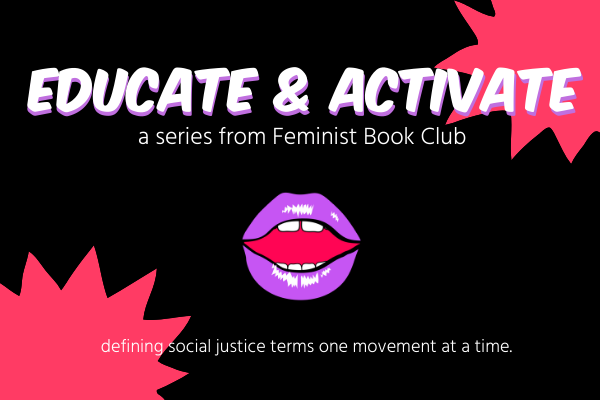Feminist Book Club blog contributors are working together to create posts in an “Educate & Activate” series. We will define a term or movement, provide historical context, and give you additional resources to learn more. We believe that an educated populace makes for better activists, accomplices and co-conspirators. It is important to note that these are meant to be brief descriptions and not inclusive, or exhaustive, of all resources. We urge you to continue being curious, and continue learning more.
Definition
Anti-racism is the work of actively opposing racism by fighting for changes in political, economic, and social life.
First Usage
1943, in the way that we use it today.
It wouldn’t be fair however, to say that anti-racism as a concept didn’t exist before 1943. One of the earliest examples we have is a letter written in 1511 by Antonio de Montesinos, a Dominican friar. In it he called out the Spanish authorities, and administrators in Hispaniola for dealing in “cruelty and tyranny” with the Indigenous people of the Island, and those forced to labor as slaves. His mantel was taken up by other friars like Bartolome de las Casas.
History
Racist sentiments followed European colonizers to the western hemisphere. The idea that the Indigenous peoples were “savages” was integral to their mission to spread Catholicism. In response to Montesinos’ letter, King Ferdinand of Spain enacted the Laws of Burgos in 1512. This was monumental because they were the first set of laws governing the behavior of Spaniards in the Americas with respect to the Indigenous people.
If we fast forward 200 years, we are now in a pre-American Revolution Philadelphia. A small group of Quakers convinced their friends to free their slaves, divest from the slave trade, and create unified policies against slavery along with the racism inherent in the act. In 1791 the term “abolitionist” was first used, and included behaviors that we consider anti-racist. It should be clearly noted that not all abolitionists were anti-racists.
Next up is the 1920s through the 1970s – yes we are skipping the Civil War and Reconstruction era and no I don’t feel badly about it. Americans were moved by the Harlem Renaissance, Jim Crow Era, and the Civil Rights movement. Additionally anti-racist works by scholars, writers and artists were published and shown more often. Examples include books like Zora Neale Hurston’s Their Eyes Were Watching God and Ralph Ellison’s Invisible Man. Artworks like Edmonia Lewis’ sculpture titled “Forever Free“, and Barbara Jones Hogu’s “Unite.” At the center were discussions about racism, the inherent value and worth of Black people, and the systems and social contracts that needed to be torn down and replaced with anti-racist institutions. Things like:
- Redlining – the practice of ensuring that Black people lived in a certain area of town – causing a shift of resources and the ability to create generational wealth.
- Segregation – a system that relegated Black people to the position of second-class citizens, lasting between 1877 and the mid-1960s.
- Individual & Interpersonal Racism – See: Everything the Ku Klux Klan did/has done/will do.
- Structural Racism – The way that the norm is white culture and Black people and their culture are seen as “other”.
Resources For Further Education
You are probably wondering why this explanation is so long, after all isn’t anti-racism the “hot new thing”?
It is not.
The work of being anti-racist has been going on in the western hemisphere for over 500 years. Below are some resources that you can use to learn more about this topic and continue the work on your own.
Being Anti-Racist – National Museum of African American History & Culture
Glossary for Understanding the Dismantling Structural Racism/Promoting Racial Equality Analysis – The Aspen Institute
TED Talks to Help You Understand Racism in America
Anti-Racism in America – A video collaboration between The Guardian and American University
Sister Outsider by Audre Lorde
The Racial Healing Handbook- Practical Activities to Help You Challenge Privilege, Confront Systemic Racism, and Engage in Collective Healing by Anneliese A. Singh
So You Want to Talk About Race by Ijeoma Oluo
How to Be an Antiracist by Ibram X. Kendi
Me and White Supremacy: Combat Racism, Change the World, and Become a Good Ancestor by Layla Saad
Road Map for Revolutionaries by Elisa Camahort Page, Carolyn Gerin and Jamia Wilson



Pingback: Children’s Book Recommendations to Fill Your Classroom and Home Library | Feminist Book Club